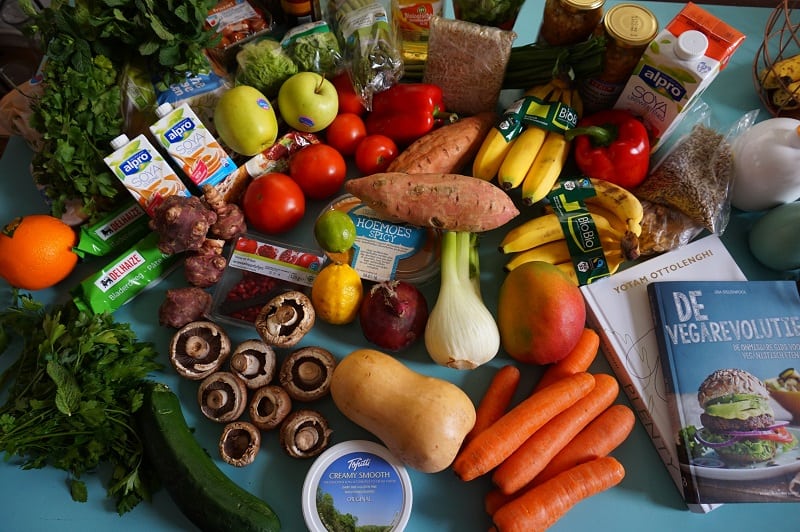After you become familiar with the basic plant-based foods you can create just about any meal. If you are uncomfortable preparing and cooking healthy plant-based dishes, I will show you how to start from scratch. You will be an expert after about a week or so!
The most common plant-based (PB) pantry essentials include dried goods such as sweet potatoes, whole grain pasta, dried beans, ground flaxseeds, cashews, dates, turmeric, garlic, lentils, oatmeal, rice, and vinegar. Eating a healthy diet is easily sustainable when you maintain a well-stocked kitchen pantry with plenty of wholesome plant foods.
How to restructure your meals around plant foods
Before transitioning to the whole plant foods lifestyle, I would commonly center my meals around some form of meat. It became very monotonous and unappealing; chicken, steak, shrimp, fish, crab, pork, lobster, turkey…. repeat.
Now I have a completely different approach to my meals. Instead of focusing on a particular animal meat, I have several food groups that are accounted for.
I always shoot for incorporating these three food groups into the majority of my meals:
- Starches
- Greens
- Legumes
This may not seem far from the monotony of a meat-centered diet, but I think you will be pleasantly surprised. There is a vast array of options in each of these three categories.
For a complete beginner’s guide to starting a plant-based lifestyle visit my related article titled: Complete Guide for Starting a Plant-Based, Vegan Diet. Here, I will walk you through step-by-step how to rearrange your environment and your mentality to succeed with your healthful dietary goals.
You may also find it helpful to download a free printable grocery list for starting on a plant-based or vegan diet asap. You can find that by clicking on my earlier article titled: Printable Plant-based SOS & Gluten-free Grocery List & Tips!
Starch

What is starch? Starch is manufactured in the green leaves of plants from excess glucose produced during photosynthesis and serves the plant as a reserve food supply. In humans and other animals, starch is broken down into its constituent sugar molecules, which then supply energy to the tissues.
Although most people avoid carbohydrates, they are our bodies’ natural fuel source. They have a bad rap due to refined carbohydrates causing inflammation and insulin resistance when eaten regularly. Refined carbs also have a tendency to cause people to gain weight.
Some examples of refined carbohydrates are:
- sugar
- white flour
- pasta
- cereal
- pastries
- bagels
- bread
- white rice
Health benefits of starch
When eating carbs in their natural form, however, such as corn vs corn-meal, they provide us with the energy needed to carry out daily metabolic processes. This is the fuel stored in our muscles ready to be utilized for exercise, running errands, playing with your kids, or even cooking your favorite plant-based meals.
By fueling your body primarily with carbohydrates rather than proteins and fats, you’ll feel satisfied, boost energy, and look and feel your best.
Dr. John McDougall
There are many benefits to including starch as the main focus of your meals.
- Satiety: Starches are greatly satiating. These foods will keep you full for many hours before arriving at your next meal.
- Fiber: These foods are naturally high in fiber, which also helps you to feel full. Fiber helps feed your healthy gut bacteria, keep your bowels regular, and keeps your appetite at bay.
- High nutrient-density: Starches are packed full of B-vitamins, calcium, and iron.
- Inexpensive: Potatoes, rice, oats, corn, and squash are some of the cheapest foods in the entire grocery store. You can enjoy these in large quantities without going over your grocery budget.
How to incorporate starches into your meals regularly
Every plant-based meal begins with some form of starch. This can be as simple as using whole grain pasta. Noodles can be made out of a variety of plant foods such as rice, wheat, quinoa, and millet. Just be sure the packaging says “whole grain” next to the first ingredient.
You can also add noodles to soups and chili to make a wholesome nutritious meal.
Steal-cut oatmeal provides a super simple breakfast. Just throw some oats and water in a slow-cooker overnight. By the time your family wakes up for the day, everyone is able to enjoy their oats with some fresh fruit, chia seeds, and dried coconut flakes.
I find stir-fries to be a great means of getting enough starch since you can throw just about anything onto a bed of rice. Mix in some edamame and spinach and you have all the essentials.
My all-time favorite starch is a sweet potato. I can eat a giant sweet potato all by its self with a little cinnamon on top. Or you can a bit more nutrition by topping it with some black beans, mixed greens, and salsa.
Here are some examples of whole starchy foods:
- potatoes
- rice
- oats
- corn
- squash
- peas
- beans
- bulgur wheat
- couscous
Dark leafy greens
I realize these are not a “pantry item” per se, but they are essential to most plant-based meals so I felt inclined to add them!
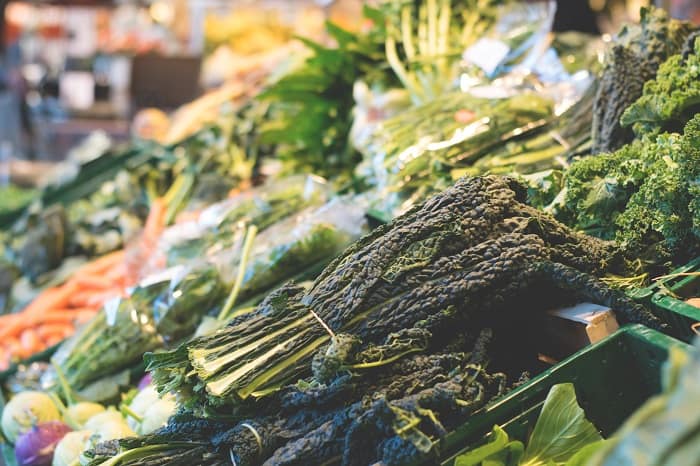
Health benefits of dark leafy greens
Dark leafy greens are packed with nutrients. They provide calcium, potassium, antioxidants, phytochemicals, zinc, iron, magnesium, selenium, and more. Greens reduce the risk of obtaining a number of health concerns including kidney stones, gout, cognitive decline, diabetes, heart disease, and sudden cardiac death.
These veggies are so under-utilized in the standard Western diet. A small trace of iceberg lettuce on your cheeseburger doesn’t quite cut it.
Greens should be eaten several times per day. They can be cooked or eaten raw. Some nutrients are destroyed by the cooking process, while others are made more readily absorbable. So be sure to get a mixture of both.
How to incorporate greens into your meals regularly
The easiest way to ensure you are getting a healthy portion of dark-leafy veggies every day is to make a big salad for one of your meals. Top it off with a variety of colorful fruits and veggies, then drizzle on some oil-free home-made dressing.
Smoothies are another great way to get in your daily greens. Mix them up with frozen fruit, flax seeds, and nut milk and you won’t even notice they’re there.
My favorite way to eat greens would be Buddha bowls! These are an easy go-to if you don’t feel like doing a lot of planning.
The base of the bowl is some kind of starch, of course. I like to use sweet potatoes, quinoa, or rice. Then, you add some kind of legume like kidney beans, black beans, lentils, chickpeas, or edamame. Now you add the greens of your choice and top everything off with oil-free dressing, salsa, soy sauce with lemon, etc.
Buddha bowls are a great way to get rid of left-overs in your fridge because you can literally throw ANYTHING in them.
Here are some examples of dark-leafy vegetables:
- spinach
- kale
- Romaine lettuce
- radicchio
- chard
- collards
- arugula
- turnip greens
- mustard greens
- beet greens
- watercress
- Chinese cabbage
Legumes
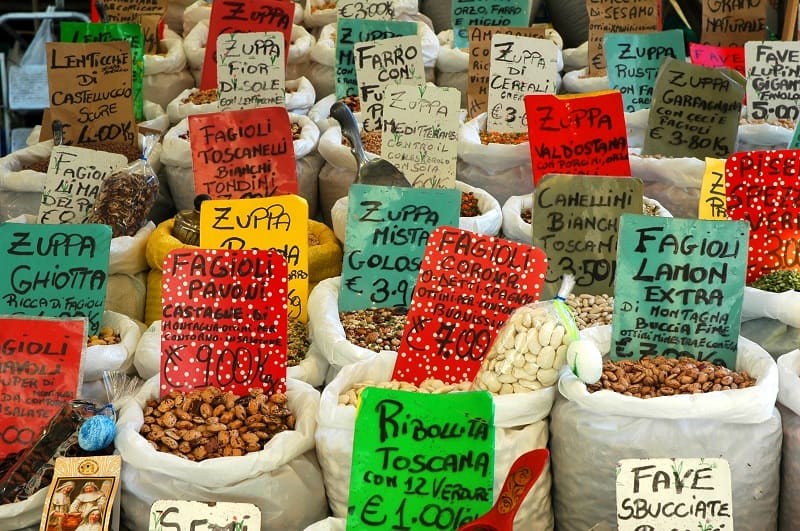
Health benefits of legumes
Lastly, we have legumes, the protein powerhouses of the plant-based family. There is a total of 28.6 grams of protein in one cup of soybeans! That is over half the Recommended Daily Allowance (RDA) of protein for both men and women!
You can find more protein measurements for common types of legumes below.
| Legume | Grams of Protein per cup |
|---|---|
| Lentils | 18 g |
| Chickpeas | 14.5 g |
| Peas | 8.2 g |
| Kidney beans | 13.4 g |
| Black beans | 15.2 g |
| Soybeans | 28.6 g |
| Pinto beans | 15.4 g |
| Navy beans | 15 g |
| Peanuts | 17.3 g |
Aside from high quantities of protein, legumes are also great sources of fiber, folate, manganese, thiamine, magnesium, iron, copper, riboflavin, phosphorus, and vitamin K.
On the other hand, legumes are low in things you don’t want a lot of, such as calories, saturated fat, sodium, and cholesterol.
Legumes are associated with high satiety, and will thus keep you feeling full for extended periods while also reducing your appetite.
How to incorporate legumes into your meals regularly
Legumes are incredibly versatile because they have a nice mild flavor. At the same time, they are so satisfying that sometimes I can eat them all by themselves.
Beans and lentils can be added to soups and salads. They are commonly used as a meat replacement in burgers, burritos, and “meat-ball” dishes.
Stir-fries are another easy option for getting more legumes into your diet. Just add your favorite legume to some sautéed veggies, then serve over rice with some low-sodium soy sauce or lemon juice.
You can even use beans as a base for some desserts. If you’ve never had black bean brownies you are surely missing out!
Mexican and Indian cuisines commonly incorporate different kinds of legumes into their meals. You can find tons of recipes for these types of tasty dishes online. Once you get the hang of it, you’ll be able to mix and match to create your own recipes.
To learn more about great plant-based food options and how to incorporate these foods into your repertoire click here to visit my earlier post titled: What Foods People Eat on a Plant-based Diet: An Easy Starter Guide
Plant-based staples
Now that you have the basic meal planning philosophy, let’s dive into our plant-based staples. The following list of items, or staples will make your starches, greens, and legumes come together nicely, while also providing added nutritional benefits.
Seeds
- pumpkin seeds
- flax seeds
- hemp sees
- chia seeds
- sesame seeds
- sunflower seeds

Health benefits of seeds
If I had to choose just one it would probably be flax seeds due to their ability to supply your body with the best building blocks to convert their short-chain fatty acids into long-chain fatty acids. The result is a healthy supply of DHA.
All seeds supply us with essential fatty acids, just in slightly different variants. Some have higher polyunsaturated fats while others have more monounsaturated fats. All provide healthy options for obtaining the fats your body requires regularly.
Seeds also have a significant amount of fiber, vitamins, and minerals such as iron, magnesium, thiamine, manganese, zinc, copper, phosphorus, and vitamin E.
The only drawback is that they do provide a substantial amount of calories per serving. For instance, one ounce of sunflower seeds contains 164 calories.
How to incorporate more seeds into your meals
As with starches and legumes, seeds are incredibly versatile with their mild, nutty taste. You can add them to any dish for a little added nutrition.
Seeds are great in smoothies or on top of smoothie bowls. You can also add them to homemade trail mix or granola.
I like to add pumpkin seeds to Buddha bowls, flax, hemp, and chia seeds to my oatmeal, sunflower seeds to my salads, tahini (sesame seeds) and flax to my salad dressing.
Flax seeds may also be used to thicken dips, sauces, and dressings. They can even be used as an egg-replacer in baking or cooking things like pancakes.
Be sure to grind your flax and chia seeds. They become much more readily absorbed and utilized by the body once they are ground.
Whole grains
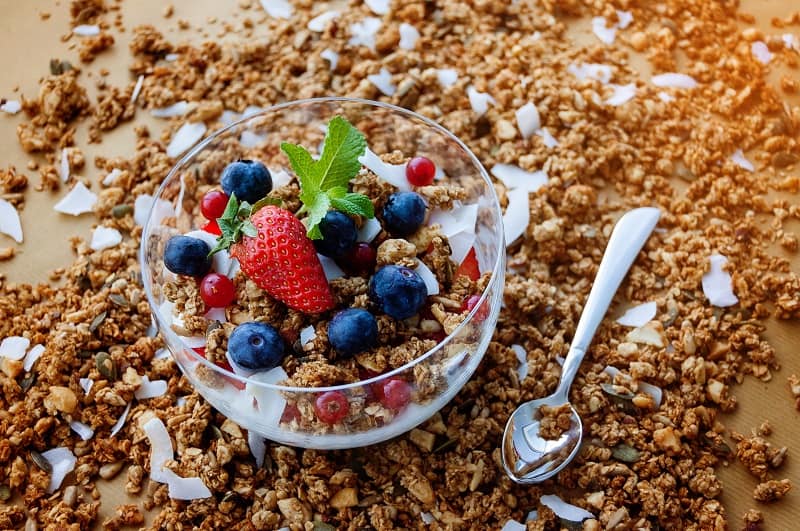
It is important to emphasize the word “whole” in this food group because the vast majority of grains in our modern supermarket have been drastically altered from their original form. You will always receive the greatest amount of nutrition a food has to offer by consuming it in its most natural state. For instance, you could purchase rice instead of rice noodles, or steel-cut oatmeal instead of oatmeal made into rolled oats, or even whole wheat bread instead of wheat bread.
There is a huge variety of grains available to most people. And each of them tends to be exceptionally cheap and tasty. You can use them in a variety of cooking styles and meals.
Some of my favorite grain staples are listed here:
- Oats
- Millet
- Quinoa (actually a seed:)
- Teff
- Rice; (basmati, jasmine, wild rice, brown rice, arborio, sticky rice, black rice, sushi rice, etc)
- Buckwheat
- Amaranth
- Sorghum
I just thought I would mention that wheat, rye, barley, triticale, spelt, couscous, wheat berries, bulgur, semolina, and farro are all perfectly fine grains to use on a plant-based diet unless you have a gluten intolerance or sensitivity. I eat a gluten-free whole-foods plant-based diet due to celiac disease, which is an autoimmune disorder triggered by the protein found in these glutinous grains.
If you have a gluten sensitivity I would also encourage you to stick to the bullet-pointed list for your grains. For anyone who does not have an adverse reaction to gluten, there isn’t a ton of evidence showing that glutinous grains are harmful to the majority of the general population. So feel free to broaden your whole-grain horizon.
Health benefits of whole grains
Whole grains are rich in protein, fiber, B vitamins and many other nutrients that help to lower blood pressure, reduce gum disease, strengthen the immune system and control weight. – Cleveland clinic
As mentioned in the “Starch” section above, whole grains provide a high amount of satiety (feeling of fullness) and appetite suppression. This is in part due to the high amounts of fiber found in whole grains.
How to incorporate more whole grains into your meals
Grains are easily incorporated into breakfast, lunch, or dinner.
I wake up nearly every morning to a huge bowl of steel-cut slow-cooked oatmeal. It takes all the work out of breakfast.
You just heat it in the slow cooker overnight in water with a little cinnamon or pumpkin pie spice if you want some extra flavor (and nutrition). Then serve with some fresh fruit, seeds, nuts, homemade granola, coconut flakes, dried fruit, cacao nibs, etc. The possibilities are truly endless.
My personal favorite topping is a simple blend of chia, hemp, and ground flax seeds with fresh berries and pecans.
I tend to mix rice into nearly all of my lunch dishes. My quick and easy go-to’s are buddha bowls. These are basically rice or some other type of grain with a salad on top. It’s super easy to incorporate legumes into this dish for some added nutrition as well.
My favorite Buddha bowl is a base of basmati rice and black beans with mixed greens, pumpkin seeds, and a variety of veggies, topped with salsa, and guacamole.
You can also use these grains in stir-fries, vegetable pastas, burritos, rice curry, soups and stews with rice or noodles, and sushi.
Condiments
Vinegar

Health benefits of vinegar
This condiment is a favorite among many plant-based followers and it has a number of health benefits.
Vinegar has been associated with weight loss when consumed regularly. Just one or two tablespoons of apple cider vinegar per day can provide a statistically significant reduction in body weight.
Vinegar may also improve blood sugar control, effectively blunting the blood sugar spike after a meal by about 20 percent. Adding vinegar in the form of dips and sauces to high glycemic foods like bread or pasta may provide as a buffer to the suddenly increased insulin response.
How to incorporate more vinegar into your meals
We have a wonderful variety of exotic vinegars available to us today. In specialty stores, you can find options like fig vinegar, blueberry, espresso, dark chocolate, blood orange, garlic & herb, tomato basil, and pomegranate vinegar.
You can use these exotic varieties in desserts. I like to make Dr. Fuhrman’s banana fig ice cream recipe. Just add some frozen bananas, fig vinegar, nut milk, and a few dried figs in a blender for a couple of minutes and you will have some delicious tasting dessert.
Most of the vinegar I consume comes from my daily salad. I may use plain balsamic vinegar with a Greek or mixed-berry salad.
But my favorite dressing is a blend of the following ingredients:
- apple cider vinegar
- brown spicy mustard
- water
- date paste
- tahini
- pepper
- garlic powder
- onion powder
- and ground flax seeds
Another great use for vinegar is sauteing vegetables. Just add vinegar in place of water or oil. It provides a flavorful twist in any stir fry.
Salsa
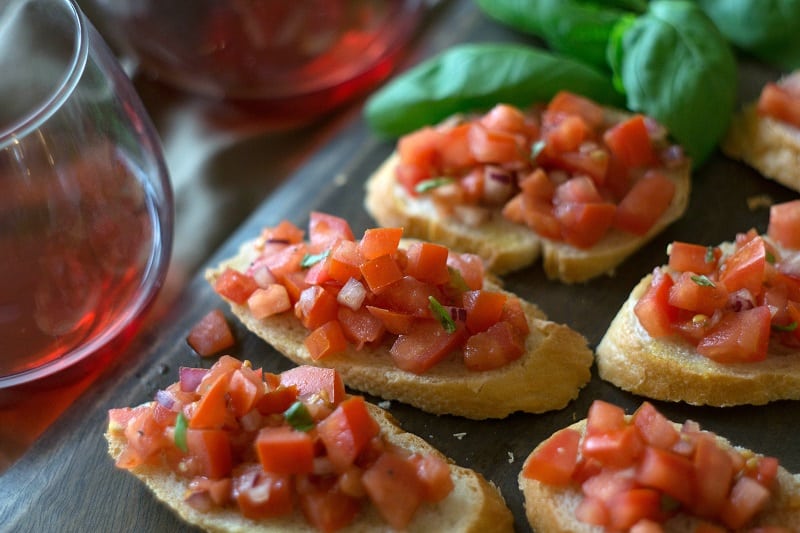
Health benefits of salsa
Most salsas are a blend of the following ingredients:
- tomatoes
- cilantro
- jalapeno peppers
- garlic
- onions
- lime
- cumin
- and chili powder
These are all highly nutritious, low-calorie foods. Saturated fat, cholesterol, and added sodium are completely absent from this Mexican condiment.
Lime juice, onions, and tomatoes are all rich sources of the antioxidant vitamin C. This water-soluble vitamin is involved in many body functions, including the formation of collagen, absorption of iron, the immune system, wound healing, and the maintenance of cartilage, bones, and teeth.
Most of the ingredients are protective against cancer, assist in weight loss, and help to lower blood sugar.
How to incorporate more salsa into your meals
Salsa is so easy to make and, like most plant-based foods, it’s extremely versatile. You can add salsa to many savory dishes for some extra flavor. We use homemade salsa on stir-fries, baked potatoes, sweet potatoes, salads, rice bowls, and tacos.
They are great for dipping raw veggies and tortilla chips. You can even pour some salsa on sandwiches and veggie wraps. Or add a little to soups and stews for a spicy kick.
I also find salsa to be a great potluck or party favor. Everyone loves chips and salsa! Just be cautious with your choice of tortilla chips. Most are drenched in oil and covered in salt. You can bake your own or use an air fryer to ensure they are healthy for snacking.
Hummus
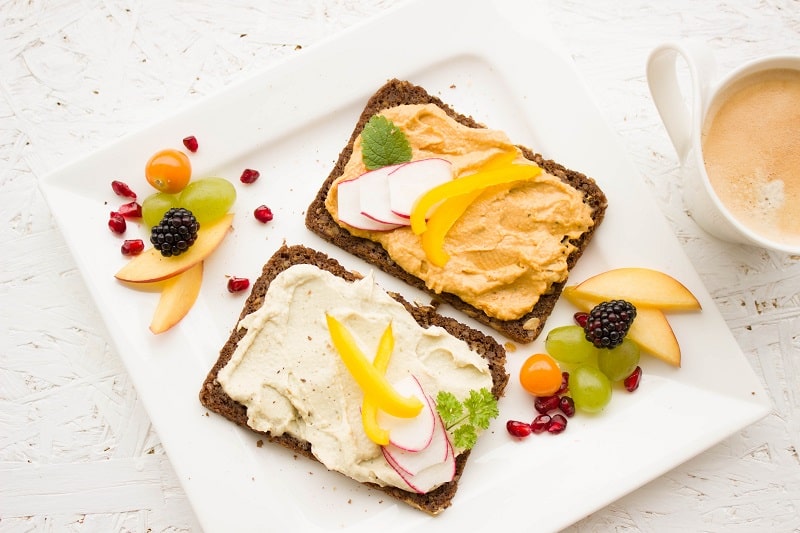
Health benefits of hummus
You can make hummus out of almost any legume, such as black beans, navy beans, lentils, and kidney beans. Most traditional forms of hummus are made from chickpeas, however. You can make these at home or find them ready-made in the grocery store near the produce.
Making your own hummus not only ensures the greatest nutrition but also allows you to get creative with the ingredients.
Most hummus dips are made with a combination of the following items:
- chickpeas
- onion
- lemon juice
- garlic
- cumin
The health benefits of legumes are laid out more thoroughly above. But just to recap, legumes such as beans, peas, chickpeas, and lentils are the protein powerhouses of the plant kingdom. Chickpeas have a whopping 14.5 grams of protein per cup!
Chickpeas, also called garbanzo beans, offer a variety of health benefits, such as improving digestion, aiding weight loss or weight management, and reducing the risk of several diseases. This legume also provides your microbiome with tons of fiber.
The rest of the ingredients are also highly beneficial in reducing the risk of disease and providing the body with essential nutrients like vitamin C, magnesium, folate, potassium, iron, and vitamin B6.
How to incorporate more hummus into your meals
Hummus, like salsa, is such a great addition to meals and snacks because it is very low in calories but high in nutrients. And therefore, you can eat as much as you like. These condiments also increase most people’s intake of veggies overall.
Hummus is not only used for dips and dressings. You can spread hummus on sandwiches and wraps, or add it to stir-fries for added flavor.
Sometimes a little extra hummus is the only way to get my 11-month old to eat her salads and raw veggies. A little extra cumin on top usually does the trick.
Homemade hummus and raw veggies are other great options to bring to social gatherings. This will ensure you have something healthy to nibble on at parties.
Spices
Turmeric

Health benefits of turmeric
The active ingredient in turmeric is curcumin. This is the component that provides curry powder with its characteristic orange pigment.
Thousands of scientific studies have experimented with and studied the many health benefits of curcumin. The spice has been shown to potentially help prevent and even arrest the promotion of cancerous tumors.
It has also been shown to prevent DNA damage and help regulate programmed cell death. In a sense, our body is rebuilding itself every few months with the building materials we provide it through our diet.
Turmeric has also been used to reduce inflammation in individuals suffering from osteoarthritis, lupus, inflammatory bowel disease, and ulcerative colitis. This feature may also assist with a speedy recovery after surgery or intense workouts.
How to incorporate more turmeric into your meals
Turmeric is traditionally an Indian spice. It is used with a lot of chickpea and rice-centered entrées. As mentioned earlier, this is one of the items used to make curry powder. So it provides a warm peppery flavor to your meals.
You can also add turmeric to roasted or sauteed veggies, smoothies, juices, potato salad, and soups.
Just be careful not to use too much. This is a very potent, flavorful spice. A quarter to a half of a teaspoon will do the trick in most instances.
I find turmeric to blend well with beans also. Sometimes I add a little to my hummus for an earthy flavoring.
Sprinkle turmeric into sautéed or braised greens like kale, collards, and cabbage. These flavors compliment each other well.
Garlic powder
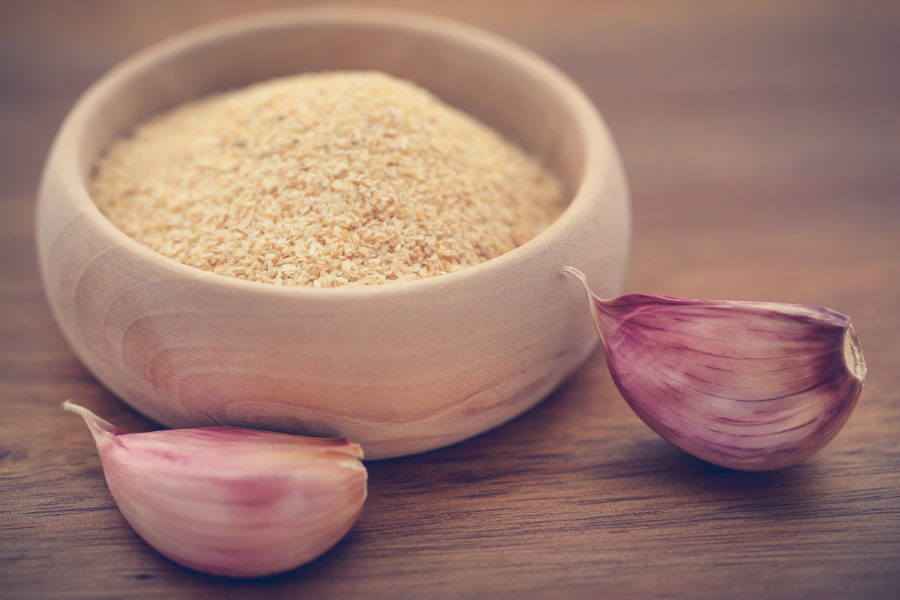
Health benefits of garlic powder
Garlic is actually part of the allium family along with onions, leeks, chives, and scallions. Some allium vegetables have been employed for millennia in traditional medical practice to treat cardiovascular diseases. They have been shown to have applications as antimicrobial, antithrombotic, antitumor, hypolipidaemic, antiarthritic and hypoglycemic agents.
It’s the organic sulfur compound allicin in garlic that gives it its pungent smell and makes it a healthy addition to your diet. Garlic has been shown in research studies to boost immunity, work as an anti-inflammatory agent, and improve the appearance of your skin and nails with its antimicrobial effects.
Garlic is also a nutritional powerhouse providing you with lots of vitamin C, manganese, vitamin B6, selenium, calcium, copper, potassium, phosphorus, iron and vitamin B1.
Although fresh garlic has slightly higher benefits than cooked or dehydrated garlic, they all provide plenty of nutrition. I cook with all types of garlic depending on the particular dish I am making.
How to incorporate more garlic powder into your meals
Everything I sautee begins with an onion and some fresh or powdered garlic. These ingredients add a lot of flavor to mild plant-based foods like rice, potatoes, and beans.
Garlic is also a common ingredient in hummus, salsa, pico de gallo, and guacamole.
Most of the garlic powder I consume in my diet comes from my homemade salad dressing. I mix it with tahini and brown spicy mustard to pour over fresh greens. It is also complimentary when used with onion powder which also provides myriad health benefits.
You can also add garlic powder to chili, sauces, roasted veggies, pastas, and soups.
Cumin
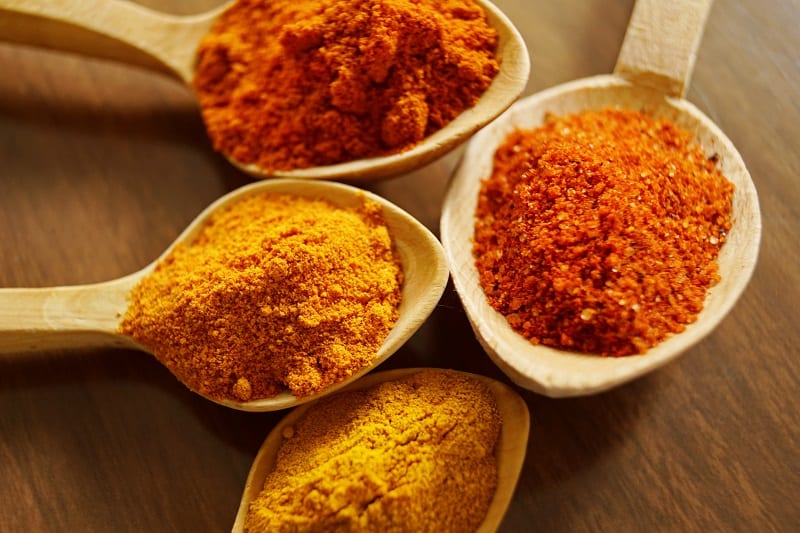
Health benefits of Cumin
Cumin is another spice with medicinal properties. It has historically been used for such ailments as indigestion, irritable bowel syndrome and other inflammatory issues. It has been shown to aid in digestion by increasing the activity of enzymes and digestive proteins.
This spice is also rich in antioxidants which aid in the reduction of free radicals that cause DNA damage and promote cancer growth.
Cumin is surprisingly very dense in iron, providing almost 20% of your daily iron in one teaspoon. This is an important contribution given the high degree of iron deficiency in much of the general population, especially those consuming a strict junk food vegan diet.
This flavorful spice is also a helpful component in weight loss and weight maintenance. Double-blind controlled clinical trials consistently show a significant loss in body fat when adding cumin to the diet of certain study participants, compared to those who were given the placebo.
How to incorporate more cumin into your meals
Cumin is very versatile in its culinary applications, as with most plant-based items. We regularly add it to our hummus, steamed veggies, chili, and burritos.
You can also add cumin to soups, stews, bean salads, roasted veggies, and pastas.
Get creative and add a little cumin to some of your favorite dishes. It may enhance the flavors even more so.
For more easy plant-based recipes check out some of my other articles listed below:
7 Healthy Comfort Food Recipes for Picky Toddlers: Vegan, Gluten-free
10 Healthy Vegan Weight Loss Snacks: Full Recipes Included
Plant-based Nutrients, Foods, & Recipes that Boost Your Immune System
How to Battle Morning Sickness with a Plant-based Diet: + Recipes
Healthy Vegan Pregnancy: Tasty Snack Recipes with Essential Nutrients

